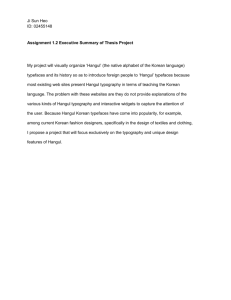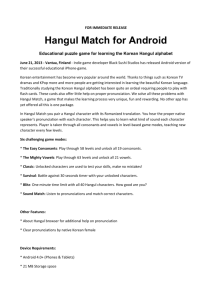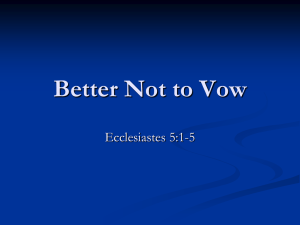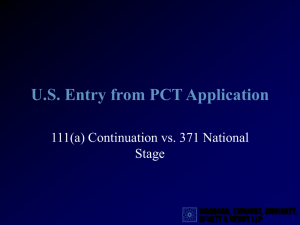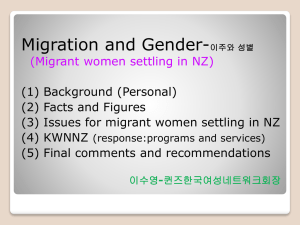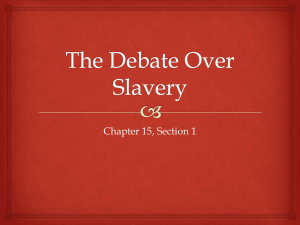Hangul
advertisement
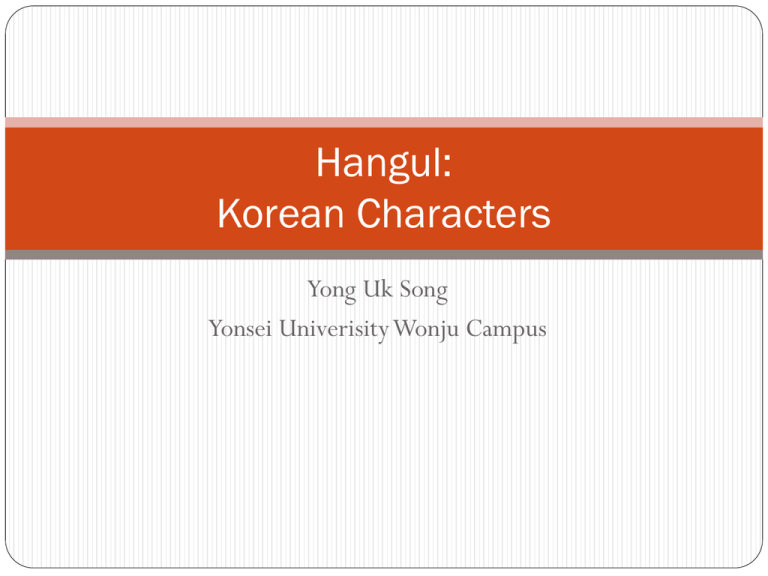
Hangul: Korean Characters Yong Uk Song Yonsei Univerisity Wonju Campus Why Hangul in Programming Class? Encoding Encoding is “mapping a meaning to a series of symbols.” E.g. HTML, … Program Human language Voice Letter How People Learn Languages? Baby Language, and then characters Adult Characters, and then language We are adults! Let’s learn Korean characters first. Introduction to Languages and Characters Languages vs. Characters Country United Kingdom U. S. A. Canada … Philippines Indonesia Malaysia Russia China Japan Korea Language Character English Alphabet Tagalog Bahasa Indonesia Bahasa Malaysia Russian Chinese Japanese Korean Alphabet Alphabet Cyrillic alphabet Chinese character Kana Hangul Examples of Characters Cyrillic alphabet АБВГДЕЖЅЗИІКЛМНОПҀРСТѸФХѠЦЧШЩЪꙐЬѢꙐѤЮѦѪѨѬѮѰѲѴ Chinese character 係印歐語系嗰斯拉夫語族嗰大多數語言用嘚嗰字母書寫系統 Kana (Japanese character) mixed with Chinese characters 主にスラヴ諸語を表記するのに用いられる表音文字の体系の一種である。 伝統的には、正教会の宣教師キュリロスとメトディオスの兄弟がスラヴ 人に布教するためにギリシャ文字を元に考案されたとされるが、彼らが 実際に考案した文字はグラゴル文字であったらしい。しかし、グラゴル 文字はすぐに廃れたため、キリル文字が広く用いられるようになり、 キュリロスが作った文字であるという意味からキリル文字と呼ばれるよ うになった Hangul (Korean character) 동유럽(러시아, 우크라이나, 벨라루스와 몰도바, 세르비아, 몬테네그로, 보스니아 헤르체고비나 일부지역, 크로아티아 일부지역, 루마니아 일부지역, 불가리아, 마케도니아 공화국)과 중앙아시아, 북아시아와 아제르바이잔, 그루지야 일부지역(압하스/압하지야, 남오세티야), 몽골에서 쓰이는 문자이다. Categories of Characters Categories Sub-categories Meaning-based (ideogram) - Chinese Character Syllable-based Ancient Phoenician Kana (Japanese) Sound-based (phonetic symbol) Examples Alphabet Phoneme-based Cyrillic alphabet Hangul (Korean) Terminology (1) Meaning-based character scheme maps a mean directly into a character. E.g. Water (in meaning) 水 (in Chinese) Sound-based character scheme maps a mean into a sound, and then maps the sound into a series of characters. E.g. Water (in meaning) [wɔ́ːtəːr] water (in English) E.g. Water (in meaning) [mul] 물 (in Korean) E.g. Water (in meaning) [tu bik] tubig (in Tagalog) Terminology (2) Syllable A unit of complete sound A segment of a spoken word consisting of one sound or of two or more sounds said as a single unit of speech Examples of one-syllable words Sing, song, run, go, … Examples of two-syllable words Singing, forget, knowledge, … Examples of words with three or more syllables Philippines, remember, … Phoneme The smallest unit of sound in a language that has significance in distinguishing one word from another A syllable can be divided into several phonemes. Two categories of phonemes Consonants (e.g. B, C, D, F, G, H, J, K, L, M, N, P, Q, R, S, T, V, W, X,Y, Z (in Alphabet)) Vowels (e.g. A, E, I, O, U (in Alphabet)) Evolution of Characters Characters have been evolved in the sequence of meaning- based, syllable-based, and finally phoneme-based, even though some languages still use meaning-based (China) or syllable-based (Japan) characters. Why? To reduce the number of symbols (characters) The more there are symbols, the more it is difficult to learn. E.g. Chinese : 30,000 or more symbols Kana : 50 + 1 symbols Alphabet : 26 symbols Uniqueness of Hangul Unique Feature of Hangul (1) Hangul is phoneme-based, but it can represent syllables, too. Example English For “river”, we can identify only consonants (r, v, r) and vowels (i, e). There is no specification about syllables. Korean For “서울” (Seoul), we can identify two syllables (서, 울) firstly, and then, one consonant (ㅅ) and one vowel (ㅓ) from 서 (Seo), and two consonants (ㅇ, ㄹ) and one vowel (ㅜ) from 울 (ul). Coverage by Alphabet and Language Phoneme English Syllable Alphabet Korean Hangul Word English Korean In English, If you do not learn a word, you may not read or write the word. E.g. School, Chair In Korean language, Even though you do not learn a word, you can read and write the word. Unique Feature of Hangul (2) Transparency (from Computer Science) The representation is transparent from its meaning in Korean thanks to Hangul. You can learn reading and writing (Hangul) without the knowledge about Korean words (vocabulary), whereas you should learn reading and writing with English words simultaneously. Reading & writing are separated from vocabulary in Korean, but reading & writing are combined with vocabulary in English. So, Hangul is very easy to learn, read and write. Unique Feature of Hangul (3) Syllable-based representation scheme of Hangul enforces no exceptions. (There are some exceptions, though) Thanks to Hangul, Korean language has a tendency to adapt itself as a pronunciation for a word is changed. Adaptation example 삯월세 (rent-fee) [sag-wol-se] 사글세 [sa-gl-se] Korean government changed the standard from 삯월세 to 사글세. English allows many exceptions. English do not adapt itself even though a pronunciation for a word is changed. Example School vs. Skul UK or USA governments do not change the word from SCHOOL to SKUL. Writing “school” but reading “skul” is still OK for them. The issues is not government officers’ attitude (diligentness or lazyness), but the tendency by the characters (Hangul and Alphabet). There is no “spelling bee” competition in Korea. Because every Korean (except babies) is a spelling bee. To Learn Hangul Symbols for Phonemes Consonants: ㄱ, ㄴ, ㄷ, ㄹ, ㅁ, ㅂ, ㅅ, ㅇ, ㅈ, ㅊ, ㅋ, ㅌ, ㅎ, ㄲ, ㄸ, ㅃ, ㅆ, ㅉ Vowels: ㅏ, ㅑ, ㅓ, ㅕ, ㅗ, ㅛ, ㅜ, ㅠ, ㅡ, ㅣ ㅐ, ㅒ, ㅔ, ㅖ ㅘ, ㅙ, ㅚ, ㅝ, ㅞ, ㅟ, ㅢ Rule of layout for consonants and vowels to represent syllables ( distinguished from other characters) Layout Rule of Layout for Syllable Con. : a consonant Section I Con. (M) Section III Section II Vow. (B) Vow. (B) Section IV Section V Con. (O) Con. (O) Vow. : a vowel M : mandatory B : at least one vowel in sections II and III Vowels with a vertical bar (ㅏ, ㅑ, ㅓ, ㅕ, ㅣ, …) locate at section III. Vowels with a horizontal bar (ㅗ, ㅛ, ㅜ, ㅠ, ㅡ, …) locate at section II. O : optional Example: Layout for Syllable (1) ㅅ Con. (M) Vow. (B) Vow. (B) ㅗ Con. (O) Con. (O) 소 [so] Example: Layout for Syllable (2) ㅅ Con. (M) ㅏ Vow. (B) Vow. (B) Con. (O) Con. (O) 사 [sa] Example: Layout for Syllable (3) ㅅ Con. (M) Vow. (B) Vow. (B) ㅗ Con. (O) Con. (O) ㅇ 송 [song] Example: Layout for Syllable (4) ㅅ Con. (M) ㅏ Vow. (B) Vow. (B) Con. (O) Con. (O) ㅇ 상 [sang] Example: Layout for Syllable – What if “Con. (M)” not exist? Void (empty, zero) consonant (ㅇ) ㅇ Con. (M) Vow. (B) Vow. (B) ㅗ Con. (O) Con. (O) 오 [o] Special Consonant - ㅇ When “ㅇ” is in section I, it means “void”. 오 [o] When “ㅇ” is in section IV, it is a consonant with its own sound, “ng”. 송 [song] Section I Con. (M) Section III Section II Vow. (B) Vow. (B) Section IV Section V Con. (O) Con. (O) Example: Layout for Syllable (5) ㄱ Con. (M) ㅏ Vow. (B) Vow. (B) ㅗ Con. (O) Con. (O) ㅇ 광 [kwang] Example: Layout for Syllable (6) ㅁ Con. (M) ㅏ Vow. (B) Vow. (B) Con. (O) Con. (O) ㄴ ㅎ 많 [man + h] * ‘h’ sound goes to next syllable. What is Good Layout? The layout result should be a square if possible. 나 (Bad) (Good) 누 (Good) (Bad) Symbols Consonants (1) Symb ol Example Sound (in English) G Get, Gag Name ㄱ 기윽 (기역) ㄴ 니은 N Name, Moon ㄷ 디읃 (디귿) D Dad ㄹ 리을 L Large, Little ㅁ 미음 M Moon, Mom ㅂ 비읍 B Baby, Bob ㅅ 시읏 (시옷) S Song, Get Consonants (2) Symb ol Example (in English) Name Sound ㅇ 이응 ㅈ 지읒 (void) Ng J Ask Song Job ㅊ 치읓 Ch Chair ㅋ 키읔 C, K ㅌ 티읕 T Top ㅍ 피읖 P Popular ㅎ 히읗 H Have Car, Kid Consonants (3) Symb ol Example Sound (in Taglog) Kk Calamansi Name ㄲ 쌍기역 ㄸ 쌍디귿 Tt Tagalog, Ate ㅃ 쌍비읍 Pp Opo ㅆ 쌍시옷 Ss Sinigang ㅉ 쌍지읒 Jj Jaz * “쌍” means “two”. Naming Rule for Consonants If ‘C’ is a consonant, C ㅣ ㅇ ㅡ C E.g. ㄴ (니은), ㄹ (리을), ㅁ (미음), … Exceptions: ㄱ (기역 기윽), ㄷ (디귿 디읃), ㅅ (시옷 시읏) Vowels (1) Symb Name ol Sound ㅏ 아 A Example (in English) Ask (in England) ㅑ 야 Ya Yahoo ㅓ 어 Eo Seoul ㅕ 여 Yeo Young ㅗ 오 O Song ㅛ 요 Yo Yogurt ㅜ 우 U Glue Vowels (2) Symb Name ol Sound ㅠ 유 Yu Example (in English) You ㅡ 으 Eu Group, Field ㅣ 이 I It ㅐ 애 Ae At ㅒ 얘 Yae ㅔ 에 E Get ㅖ 예 Ye Yes Vowels (3) Symb Name ol Sound ㅘ 와 Wa Example (in English) What ㅙ 왜 ㅚ 외 Ō (German) Kōnig (German) ㅝ 워 Were ㅞ 웨 Wage ㅟ 위 ㅢ 의 We We Naming Rule for Vowels As it is, by adding the “void” consonant, ㅇ in Section I. E.g.) ㅏ아 ㅗ오 ㅐ애 ㅘ와 Writing Guideline Left to right, then top to down Maintain SQUARE layout if possible Writing Consonants (1) Symb ol Name ㄱ 기윽 (기역) ㄴ 니은 ㄷ 디읃 (디귿) ㄹ 리을 ㅁ 미음 ㅂ 비읍 ㅅ 시읏 (시옷) Sequence Writing Consonants (2) Symb ol Name ㅇ 이응 ㅈ 지읒 ㅊ 치읓 ㅋ 키읔 ㅌ 티읕 ㅍ 피읖 ㅎ 히읗 Sequence Writing Vowels (1) Symb ol Name ㅏ 아 ㅑ 야 ㅓ 어 ㅕ 여 ㅗ 오 ㅛ 요 ㅜ 우 Sequence Writing Vowels (2) Symb ol Name ㅠ 유 ㅡ 으 ㅣ 이 ㅐ 애 ㅒ 얘 ㅔ 에 ㅖ 예 Sequence Vowels (3) Symb ol Name ㅘ 와 ㅗㅘ ㅙ 왜 ㅗㅙ ㅚ 외 ㅗㅚ ㅝ 워 ㅜㅝ ㅞ 웨 ㅜㅞ ㅟ 위 ㅜㅟ ㅢ 의 ㅡㅢ Sequence ?
